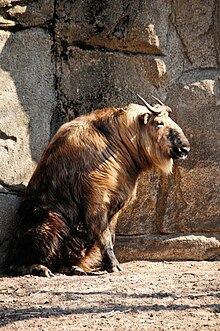Budorcas taxicolor tibetana
| Sichuan takin | |
|---|---|
 |
|
| A Sichuan takin at the Lincoln Park Zoo | |
| Scientific classification | |
| Kingdom: | Animalia |
| Phylum: | Chordata |
| Class: | Mammalia |
| Order: | Artiodactyla |
| Family: | Bovidae |
| Subfamily: | Caprinae |
| Genus: | Budorcas |
| Species: | B. taxicolor |
| Subspecies: | B. t. tibetana |
| Trinomial name | |
|
Budorcas taxicolor tibetana Milne-Edwards, 1868 |
|
 |
|
| Distribution of the Sichuan takin | |
The Sichuan takin or Tibetan takin (Budorcas taxicolor tibetana) is a subspecies of takin (goat-antelope). Budorcas from Greek bous ("ox" or "cow") and dorkas ("gazelle"); taxicolor from Latin taxus ("badger") and color ("hue") referring to badger-like coloration Listed as a vulnerable species, the Sichuan takin is native to Tibet and the provinces of Sichuan, Gansu and Xinjiang in the People's Republic of China.
It can be differentiated from its close cousin, the golden takin, largely by its coat color among other morphological differences, in addition to a different range of habitat. The takin was previously considered closely related to the Arctic muskox. Physical similarities have now been found to be due to convergent evolution and not through a common ancestor. DNA sequencing recently revealed various sheep are close relatives (goats, tahrs, sheep, bharal, Barbary sheep).
Takin inhabit the same dense bamboo forests as the better known giant panda. Sichuan takins live in these dense thickets and bamboo groves, in family groups of up to 30 individuals. Despite being large, stocky and relatively slow moving, the Sichuan takin is quite agile in maneuvering its rocky habitat with often steep and challenging slopes. The inaccessibility of the takin’s mountainous habitat has meant that there is little information on this species’ behavior and ecology; specifically on their distribution and population size.
Although considered a national treasure of China with the highest legal protection, the Sichuan takin is threatened by ongoing poaching and habitat destruction. The highest need for this species is further scientific knowledge to allow production of a valid long-term conservation and management plan. The principal threats to its survival include poaching by hunters for food and fur. This has led to their decline in the wild. A reliable count of the species has not been fully undertaken, but it may have indirectly benefited from the protections accorded to the giant panda and other species.
...
Wikipedia

